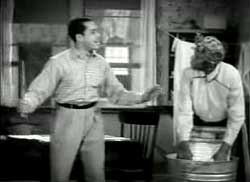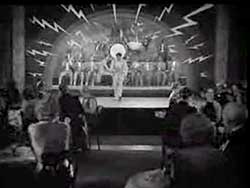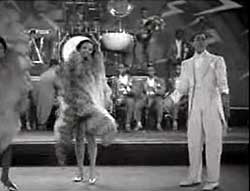 Besides the movie Hi De Ho (1947) directed by Josh Binney, there was also one-reel Vitaphone film directed by Roy Mack has a different version of the title song, also titled Hi De Ho (1937). It includes three additional songs framed in a delightful though slim story.
Besides the movie Hi De Ho (1947) directed by Josh Binney, there was also one-reel Vitaphone film directed by Roy Mack has a different version of the title song, also titled Hi De Ho (1937). It includes three additional songs framed in a delightful though slim story.
The tale opens with a sweet, amusing notion. Cab is playing the radio & pretending to be a band leader. In front of the radio he has placed little glass miniatures of musicians. He's smiling happily & dance-conducting around the small apartment, while his mom washes clothes in a tub with washboard.
She asks what in the world he's doing waving that stick around like that. When he says he's practicing to be a conductor, she she tells him the only conducting he'll ever do is as a pullman porter. "Not me! I'm going places someday! Might go to Broadway, might go to Paris."
 When he makes it in this world, he promises she'll no longer have to take in laundery. When he makes it in this world, he promises she'll no longer have to take in laundery.
Mom says, "You don't have to worry about me. I don't have no say in the matter." Cab says, "But I do. Listen to this," & he begins to sing "I've Got a Right to Sing the Blues" along with the band on the radio:
"I've got a right to sing the blues/ I got a right to feel low down/ I got a right to hang around/ Wayyyyyy down by the river."
This number was written by Harold Arlen & Ted Koehler, songwriting giants of the 1930s, with even "Stormy Weather" to their amazing shared credit.
For a blues song, it's just so Cab Calloway chipper, & a wonderful piece. And I could really buy the whole idea that a guy like Cab, if he weren't already famous, would fell glad satisfiction merely to sing to his lovely old mom.
The deacon passing by on the street leans in the open window. He's convinced such a talented man has a future, & he invites Cab over to his house so his wife who reads tea-leaves.
 The deacon's wife looks into the tealeaves & says, "I see that you is an unemployed genius & you is looking for a job." The deacon's wife looks into the tealeaves & says, "I see that you is an unemployed genius & you is looking for a job."
But then she really sees something, a complete vision of Cab with a band, which he's conducting in the street right in front of his own apartment house.
The musicians from Cab's Cotton Club Orchestra hang out of the windows & in the doorway, behind & above him.
In this vision he's singing "Hi De Ho Miracle Man," written by Benny Davis (who wrote the lyrics for "Baby Face") & J. Fred Coots (who wrote "Santa Claus is Coming to Town"). Cab sings:
"I'm the hi de ho miracle man/ I can really do wonders, I can/ If you've got the misery/ Bring your misery to me/ I'm the Hi-Do-Ho Miracle Man."
"Hi De Ho Miracle Man" by Davis & Coots is not the same song as "Hi De Ho Man" from the 1947 film; this latter was written by Calloway, Jack Palmer, & Buster Harding.
As the king of Hi De Ho, Cab couldn't just stick with one hi-de-ho song, & others include "Hi De Ho Romeo" by Davis & Coots, recorded in 1937; "Hi De Ho Serenade" by Walter "Foots" Thomas & Calloway, recorded in 1940, this one being a lullaby for Smoky Joe & Minnie the Moocher; "Keep that Hi De Hi in Your Soul" recorded in 1935, written by Cab. Plus numerous other songs that at least incorporate the phrase.
Back in the gloomily lit kitchen getting his tea-leaves read, the deacon's wife predicts trouble in his future, something to do with a woman. And we go into a second vision in the teacup.
 It's night. Cab's wandering downcast in the street near his apartment block. His band appear as silhouettes at drawn blinds of the apartment windows, playing a mournful dirge. It's night. Cab's wandering downcast in the street near his apartment block. His band appear as silhouettes at drawn blinds of the apartment windows, playing a mournful dirge.
He sings the spooky number about the death of a friend to all:
"Frisco Flo was just a regular gal/ Frisco Flo was just a typical my gal sal/ Frisco Flo was just a sharp as a tack, woh OHHH ohh/ Frisco Flo she'd help a fellow, give a shirt right off of her back." It's a hell of a good song, again written by Davis & Coots.
The third vision in the cup is Cab, as the deacon's wife describes it, "ridin' high, sitting on top of the world":
His orchestra is all dressed ihn white. He's in black. They're on a big stage doing the instrumentation for "Some of These Days."
It begins with lead flute of all instruments, for Walter "Foots" Thomas played clarinet, tenor sax, & occasionally flute for Cab. Momentarily Cab goes into the wildest scat vocal that ever was, then a coronet picks up those wild notes for the close, & a wonderful little film is finished.
 Kind of odd that two films starring Cab Calloway titled Hi De Ho weren't sufficient, as there'd been an even earlier one-reel film with the slightly longer title, Cab Calloway's Hi De Ho (1934), directed by Fred Weller.
Kind of odd that two films starring Cab Calloway titled Hi De Ho weren't sufficient, as there'd been an even earlier one-reel film with the slightly longer title, Cab Calloway's Hi De Ho (1934), directed by Fred Weller.
Cab is asleep in a train's lower berth in his band's private railroad car en route to New York. The porter comes through calling, "Telegram for Mr. Cab Calloway."
It's from Irving Mills (an actual music publisher who also bankrolled many films for Harlem Renaissance jazz performers) informing Cab the band will have to will have to come up with a brand new opening number for their Cotton Club gig the very next day.
Every man in the band is awakened to rehearse all night. They begin playing a railroad train & tracks rhythm, then a trumpet bursts into the hottest hot jazz. The camera shows us musician after musician performing in their berths, while Cab dance-conducts from the aisle.
The pullman porter Sam says his wife will be so thrilled to learn he took care of Cab Calloway & his orchestra, for "she's just a steppin' out fool" when it comes to jazz.
 Cab's a little disapproving of a married woman stepping out when her man's away. He advises Sam to get her a quality radio so she can enjoy jazz without stepping out on the town. It's something Sam will do, too. And the first thing that radio will bring into the home of Sam & his wife will be Cab Calloway live from the Cotton Club. Cab's a little disapproving of a married woman stepping out when her man's away. He advises Sam to get her a quality radio so she can enjoy jazz without stepping out on the town. It's something Sam will do, too. And the first thing that radio will bring into the home of Sam & his wife will be Cab Calloway live from the Cotton Club.
On the Cotton Club stage, he's singing their new opening song "Zaz Zuh Zaz," a call & reply number very much like "Minnie the Moocher":
"Now here's a very entrancing phrase/ It will put you in a daze/ But to me it don't mean a thing/ Because it's got a very peculiar swing/ Zazu zazu zazu zasu (Zazu zasu zasu zasu)/ Wohhh zo zazu zazz zu-zay (Wohhh zo zazu zazz zu-zay)."
Sam heads off for Chicago on his porter job & will be gone a week. HIs wife, far from staying home while Sam's away, immediately heads down to the Cotton Club hoping to get to know Cab, who doesn't know this desirous gal is Sam's wife.
On the stage he performs what he calls "one of my novelty numbers," namely "The Lady With the Fan." As he sings it, there's a hot fan-dancer traipsing around him with two enormous fans. Then a second fan-dancer strides out, & eventually a third. Cab sings lyrics that shares characters in common with "Minnie the Moocher":
"The lady with the fan/ The lady with the fan/ She makes Smoky Joe so ginny/ He forgot about his Minnie/ Woooh, the lady with the fan." There's lots of hip scatting to follow.
Cab wrote this number in 1933, for an actual Cotton Club fan dancer named Amy Spencer, & it'd be great if one of these three fan-dancers was Amy, though none of them are credited. In the lesser clubs during Prohibition, Amy reputedy put the fans aside in order to pick up tips off tables using only her vagina. So if this little film seems morally suspect with the cuckholdry going on, consider the times! It's actually very cleaned up compared to the real thing.
Sam's wife's at a corner table brought an enormous fan to be sure she gets the band leader's attention. Now the Cotton Club weirdly enough in this racist world we live in was for whites only where the audience & table service were concerned. And we do see the white audience at their tables.
 But I'll go ahead & take this little film's word for it that there was way off in a corner a place partitioned off for black folk, perhaps intended for performers' family or friends, I dunno. Cab comes down from the stage, crosses the floor, & sits with the lady who brought the fan. But I'll go ahead & take this little film's word for it that there was way off in a corner a place partitioned off for black folk, perhaps intended for performers' family or friends, I dunno. Cab comes down from the stage, crosses the floor, & sits with the lady who brought the fan.
In no time at all he's in her web. However, in bringing Cab back to her place for some heavy petting, she has told Cab she's married to a pullman porter "a thousand miles away in Chicago."
Cab doesn't seem to mind she married, but when Sam unexpectedly comes home because of a scheduling change, Cab gets more of a surprise than he'd hoped for.
Lying atop the bed in the other room, not knowing the gal's husband has shown up, Cab's getting tired of waiting for her to come in. He gives out a call of "Hi de hi di hi, ho de ho de ho!"
"Who's that?" says Sam, alarmed. "Why, that's Cab Calloway honey," she says nervously, trying to convince Sam it's the radio. But Sam knows better, draws his pistol, & yells for whoever it is to come out.
The one-reel film has by now run its full length of just under ten minutes, so comes to a rapid close on a corny jest. Cab not only comes running out of the bedroom, but so does his entire band which hadn't actually been in the place. They're all playing, "I Love a Parade," marching right out of the place.
copyright © by Paghat the Ratgirl
|

